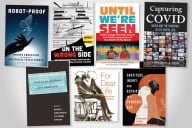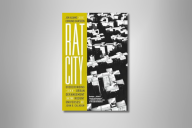You have /5 articles left.
Sign up for a free account or log in.
Last month, Thomas M. Kean and Lee H. Hamilton published Without Precedent, an account of their time as co-chairs (Republican and Democratic, respectively) of the 9/11 Commission. Whatever the uses of a deliberate and scrupulous bipartisanship in political life, it does not make for good memoir-writing. I read it, but kept slipping into that mild coma that is an occupational hazard for anyone who reviews a lot of not-very-good or just-sort-of-okay books for newspapers.
Yet one thing about Without Precedent did prove quite interesting: the strong emphasis on conspiracy theorists. Or rather, to be more exact, the authors' preoccupation with trying to head them off at the pass. The spectre of the Warren Commission must have haunted their dreams. They put a lot of thought into establishing what they call "core principles" intended to prevent "the kinds of conspiracy theorizing that have followed in the wake of other inquiries." They mention this guiding intention not once or twice, but roughly a dozen times.
"We decided to be open and transparent," they write, "so that people could see how we reached our conclusions about 9/11, and we demanded access to every document and witness in part to demonstrate that we had left no stone unturned in our investigation. We also adopted a policy of openness to the general public: people could send information to our offices, and somebody would review that information."
Clearly preventing conspiracy theory was a major concern -- which also suggests that Kean and Hamilton must have known that it was, for all practical purposes, an effectively hopeless endeavor. The impulse to frame things in terms of conspiracy has very deep roots. It is not an American specialty, by any means. But there is something sobering about reading the pamphlets from the years just before the Revolution and discovering that the patriots were, let's say, a tad paranoid at times. (George Washington worried about the "systematic plan" of King George and minions to turn the colonists into slaves "as tame and abject," as he put it in an interesting turn of phrase, "as the blacks we rule over with such arbitrary sway.")
The idea that malevolent secret forces are at work behind current events is much too seductive to banish. And now, as the fifth anniversary of the attacks approaches, we have regular reminders that the 9/11 commissioners' efforts at prophylaxis have failed. The single best-publicized source of conspiracy theory on the matter is a group calling itself Scholars for 9/11 Truth whose members have been much in the news lately. Both Kevin Barrett and William Woodward belong to the group, and I've read Barrett's work in one of their journals.
Now, a word about labels before we go on. You will not find many kind words about the "The 9/11 Commission Report" in publications associated with Scholars for 9/11 Truth, such as the magazine Global Outlook. (It is now starting to show up at some newsstands, inconspicuously mixed in with other journals of news and commentary.)
But not all criticisms of the report have been works of conspiracy theory, by any means. A few months after it appeared, the essayist Benjamin DeMott made a shrewd initial assessment of the punches pulled by the commission in the course of its investigation. And there is a tough-minded little book by the political reporter James Ridgeway called The Five Unanswered Questions about 9/11, published last year. Each sees the official account of 9/11 as inadequate. The commission (they contend) did not push hard enough to identify and hold accountable those whose malfeasance permitted the terrorists a chance to strike.
According to Scholars for 9/11 Truth, however, the events of that day were not a product of systemic failure. Very much to contrary: It was an all-around success for the U.S. government, which attacked its own citizens and, in the case of the Twin Towers, used hidden explosives to bring them down through "controlled demolition," since the impact of two jetliners could not have done it.
Furthermore, there may have been a third plane in the air at the time. "Was it meant to confuse defensive response?" asks a contributor to The Journal of 9/11 Truth, published by the group. "Was it monitoring (or controlling) the attacks? Was it a back-up in the event of a miss on the towers?"
Let's ask another question, just to round things out: Did that mysterious third plane near the Trade Center actually, you know, exist?
My first encounter with this group's work was in February, when I came across a paper by James H. Fetzer, a professor emeritus of philosophy at the University of Minnesota at Duluth, whose name seemed vaguely familiar. And so it was. I had interviewed him some year back about one of his books. Before 9/11, he had carved out a niche for himself in the world of JFK "assassinologists." (You are supposed to call them that. "Buffs" just makes them mad.)
Anyway, Fetzer had done some really groundbreaking work on the famous Zapruder film, which you have almost certainly seen at some point, whether or not you knew that was what it is called. It is the short, grainy, rather shaky home movie of the Kennedy motorcade in Dallas, in which the viewer sees the back of the president's head explode in a cloud of blood and brains.
Other conspiracy-minded researches had studied the horrific images, frame by frame, in an effort to determine just how many gunmen were involved and where they might be located. The ensuing debates kept assassinologists occupied for many years.
To Fetzer, their work seemed naive. He argued (at great length, and in a depth of detail that I cannot pretend to have fathomed) that the Zapruder film itself is a hoax. "The film was redone using techniques of optical printing and special effects," as Fetzer has explained, if "explained" is the word one wants, "which allow combining any background with any foreground to create any impression that one desires, which included removing series of frames that would have given the plot away, such as that the driver pulled the limousine to the left and stopped after shots began to be fired...."
Assassinology has been an overcrowded discipline for some time. Even in the mid-1970s, newcomers were being encouraged to specialize in ever more narrow sub-fields. (That advice sounds kind of familiar, doesn't it?)
By contrast the subject of 9/11 offers a whole new set of problems. It demands fresh new developments in conspiratorial research -- new theoretical approaches to explain the evidence, or even to bring it into existence, as in the case of the mystery jet.
It proves difficult to read very much of this material without recalling that Richard Hofstadter once devoted a book to The Paranoid Style in American Politics (1965). Over the years, historians have spent a lot of time arguing with this or that element of its argument, and my friend Rick Perlstein has been merciless in his treatment of how Hofstadter approached Barry Goldwater.
Whatever its failings as analysis, though, Hofstadter's book is very good indeed as phenomenological description. So it is no surprise to find a good explanation for Scholars for 9/11 Truth in it, even though Hofstadter himself died in 1970.
The conspiratorial mentality or "paranoid style" -- for which important events in public life are best understood as the product of hidden, malevolent forces controlling history -- is strongly prone to assuming a scholarly form. As Hofstadter puts it: "One should not be misled by the fantastic conclusions that are so characteristic of this political style into imagining that it is not, so to speak, argued out along factual lines. The very fantastic character of its conclusions leads to heroic strivings
for 'evidence' to prove that the unbelievable is the only thing that can be believed."
The charge that conspiratorial thinking is incoherent simply will not hold up. "It is nothing if not coherent," writes Hofstadter. The conspiratorial understanding of history is actually "far more coherent than the real world, since it leaves no room for mistakes, failures, or ambiguities. It is, if not wholly rational, at least intensely rationalistic...."
And finally, it gives people overwhelmed by history something to do -- nothing very useful, perhaps, but then you can't have everything. It demands "the laborious accumulation of what can be taken as convincing evidence for the most fantastic conclusions," writes Hofstadter, "the careful preparation for the big leap from the undeniable to the unbelievable."
Well, there are all sorts of ways of handling trauma. It's no surprise that this one has emerged. Whether or not 9/11 itself could have been prevented, something like Scholars for 9/11 Truth was perhaps
inevitable.
But so is the free exercise of critical intelligence, which is why I am glad to be able to end with this link to an encouraging development: The Journal of Debunking 9/11 Conspiracy Theories.








